Zaid Alyafeai
Arabic Stable LM: Adapting Stable LM 2 1.6B to Arabic
Dec 05, 2024Abstract:Large Language Models (LLMs) have shown impressive results in multiple domains of natural language processing (NLP) but are mainly focused on the English language. Recently, more LLMs have incorporated a larger proportion of multilingual text to represent low-resource languages. In Arabic NLP, several Arabic-centric LLMs have shown remarkable results on multiple benchmarks in the past two years. However, most Arabic LLMs have more than 7 billion parameters, which increases their hardware requirements and inference latency, when compared to smaller LLMs. This paper introduces Arabic Stable LM 1.6B in a base and chat version as a small but powerful Arabic-centric LLM. Our Arabic Stable LM 1.6B chat model achieves impressive results on several benchmarks beating multiple models with up to 8x the parameters. In addition, we show the benefit of mixing in synthetic instruction tuning data by augmenting our fine-tuning data with a large synthetic dialogue dataset.
Rephrasing natural text data with different languages and quality levels for Large Language Model pre-training
Oct 28, 2024



Abstract:Recently published work on rephrasing natural text data for pre-training LLMs has shown promising results when combining the original dataset with the synthetically rephrased data. We build upon previous work by replicating existing results on C4 and extending them with our optimized rephrasing pipeline to the English, German, Italian, and Spanish Oscar subsets of CulturaX. Our pipeline leads to increased performance on standard evaluation benchmarks in both the mono- and multilingual setup. In addition, we provide a detailed study of our pipeline, investigating the choice of the base dataset and LLM for the rephrasing, as well as the relationship between the model size and the performance after pre-training. By exploring data with different perceived quality levels, we show that gains decrease with higher quality. Furthermore, we find the difference in performance between model families to be bigger than between different model sizes. This highlights the necessity for detailed tests before choosing an LLM to rephrase large amounts of data. Moreover, we investigate the effect of pre-training with synthetic data on supervised fine-tuning. Here, we find increasing but inconclusive results that highly depend on the used benchmark. These results (again) highlight the need for better benchmarking setups. In summary, we show that rephrasing multilingual and low-quality data is a very promising direction to extend LLM pre-training data.
ArabicMMLU: Assessing Massive Multitask Language Understanding in Arabic
Feb 20, 2024Abstract:The focus of language model evaluation has transitioned towards reasoning and knowledge-intensive tasks, driven by advancements in pretraining large models. While state-of-the-art models are partially trained on large Arabic texts, evaluating their performance in Arabic remains challenging due to the limited availability of relevant datasets. To bridge this gap, we present ArabicMMLU, the first multi-task language understanding benchmark for Arabic language, sourced from school exams across diverse educational levels in different countries spanning North Africa, the Levant, and the Gulf regions. Our data comprises 40 tasks and 14,575 multiple-choice questions in Modern Standard Arabic (MSA), and is carefully constructed by collaborating with native speakers in the region. Our comprehensive evaluations of 35 models reveal substantial room for improvement, particularly among the best open-source models. Notably, BLOOMZ, mT0, LLama2, and Falcon struggle to achieve a score of 50%, while even the top-performing Arabic-centric model only achieves a score of 62.3%.
Aya Dataset: An Open-Access Collection for Multilingual Instruction Tuning
Feb 09, 2024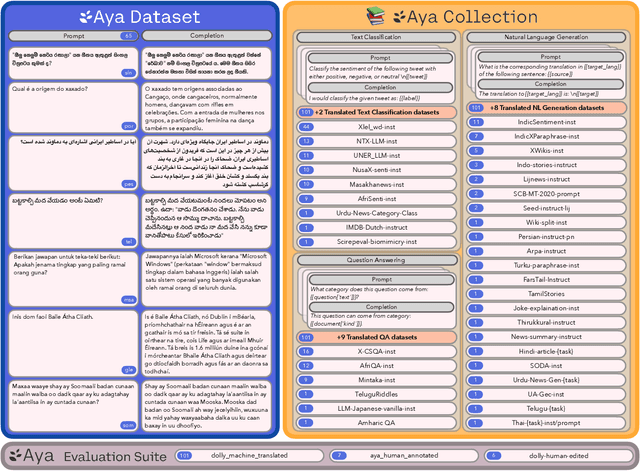
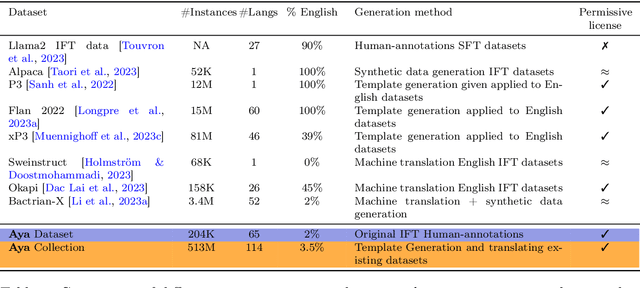
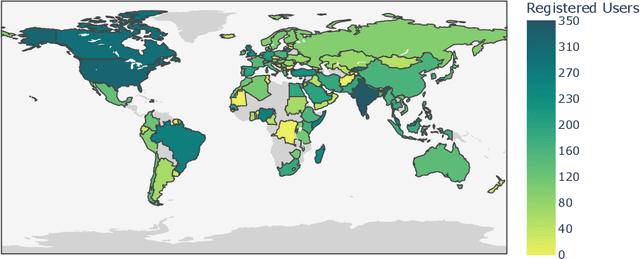
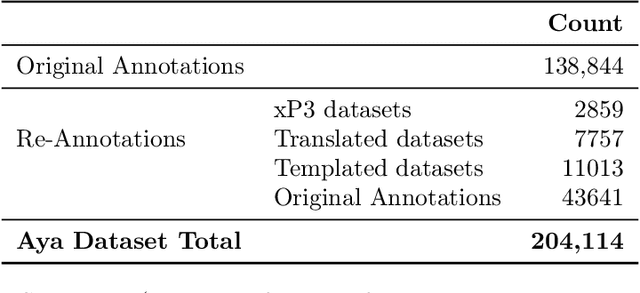
Abstract:Datasets are foundational to many breakthroughs in modern artificial intelligence. Many recent achievements in the space of natural language processing (NLP) can be attributed to the finetuning of pre-trained models on a diverse set of tasks that enables a large language model (LLM) to respond to instructions. Instruction fine-tuning (IFT) requires specifically constructed and annotated datasets. However, existing datasets are almost all in the English language. In this work, our primary goal is to bridge the language gap by building a human-curated instruction-following dataset spanning 65 languages. We worked with fluent speakers of languages from around the world to collect natural instances of instructions and completions. Furthermore, we create the most extensive multilingual collection to date, comprising 513 million instances through templating and translating existing datasets across 114 languages. In total, we contribute four key resources: we develop and open-source the Aya Annotation Platform, the Aya Dataset, the Aya Collection, and the Aya Evaluation Suite. The Aya initiative also serves as a valuable case study in participatory research, involving collaborators from 119 countries. We see this as a valuable framework for future research collaborations that aim to bridge gaps in resources.
CIDAR: Culturally Relevant Instruction Dataset For Arabic
Feb 05, 2024Abstract:Instruction tuning has emerged as a prominent methodology for teaching Large Language Models (LLMs) to follow instructions. However, current instruction datasets predominantly cater to English or are derived from English-dominated LLMs, resulting in inherent biases toward Western culture. This bias significantly impacts the linguistic structures of non-English languages such as Arabic, which has a distinct grammar reflective of the diverse cultures across the Arab region. This paper addresses this limitation by introducing CIDAR: https://hf.co/datasets/arbml/CIDAR, the first open Arabic instruction-tuning dataset culturally-aligned by human reviewers. CIDAR contains 10,000 instruction and output pairs that represent the Arab region. We discuss the cultural relevance of CIDAR via the analysis and comparison to other models fine-tuned on other datasets. Our experiments show that CIDAR can help enrich research efforts in aligning LLMs with the Arabic culture. All the code is available at https://github.com/ARBML/CIDAR.
Ashaar: Automatic Analysis and Generation of Arabic Poetry Using Deep Learning Approaches
Jul 12, 2023Abstract:Poetry holds immense significance within the cultural and traditional fabric of any nation. It serves as a vehicle for poets to articulate their emotions, preserve customs, and convey the essence of their culture. Arabic poetry is no exception, having played a cherished role in the heritage of the Arabic community throughout history and maintaining its relevance in the present era. Typically, comprehending Arabic poetry necessitates the expertise of a linguist who can analyze its content and assess its quality. This paper presents the introduction of a framework called \textit{Ashaar} https://github.com/ARBML/Ashaar, which encompasses a collection of datasets and pre-trained models designed specifically for the analysis and generation of Arabic poetry. The pipeline established within our proposed approach encompasses various aspects of poetry, such as meter, theme, and era classification. It also incorporates automatic poetry diacritization, enabling more intricate analyses like automated extraction of the \textit{Arudi} style. Additionally, we explore the feasibility of generating conditional poetry through the pre-training of a character-based GPT model. Furthermore, as part of this endeavor, we provide four datasets: one for poetry generation, another for diacritization, and two for Arudi-style prediction. These datasets aim to facilitate research and development in the field of Arabic poetry by enabling researchers and enthusiasts to delve into the nuances of this rich literary tradition.
Taqyim: Evaluating Arabic NLP Tasks Using ChatGPT Models
Jun 28, 2023



Abstract:Large language models (LLMs) have demonstrated impressive performance on various downstream tasks without requiring fine-tuning, including ChatGPT, a chat-based model built on top of LLMs such as GPT-3.5 and GPT-4. Despite having a lower training proportion compared to English, these models also exhibit remarkable capabilities in other languages. In this study, we assess the performance of GPT-3.5 and GPT-4 models on seven distinct Arabic NLP tasks: sentiment analysis, translation, transliteration, paraphrasing, part of speech tagging, summarization, and diacritization. Our findings reveal that GPT-4 outperforms GPT-3.5 on five out of the seven tasks. Furthermore, we conduct an extensive analysis of the sentiment analysis task, providing insights into how LLMs achieve exceptional results on a challenging dialectal dataset. Additionally, we introduce a new Python interface https://github.com/ARBML/Taqyim that facilitates the evaluation of these tasks effortlessly.
The BigScience ROOTS Corpus: A 1.6TB Composite Multilingual Dataset
Mar 07, 2023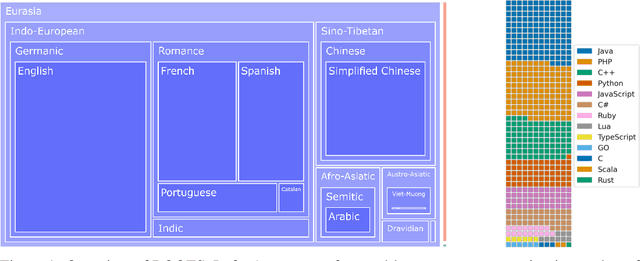



Abstract:As language models grow ever larger, the need for large-scale high-quality text datasets has never been more pressing, especially in multilingual settings. The BigScience workshop, a 1-year international and multidisciplinary initiative, was formed with the goal of researching and training large language models as a values-driven undertaking, putting issues of ethics, harm, and governance in the foreground. This paper documents the data creation and curation efforts undertaken by BigScience to assemble the Responsible Open-science Open-collaboration Text Sources (ROOTS) corpus, a 1.6TB dataset spanning 59 languages that was used to train the 176-billion-parameter BigScience Large Open-science Open-access Multilingual (BLOOM) language model. We further release a large initial subset of the corpus and analyses thereof, and hope to empower large-scale monolingual and multilingual modeling projects with both the data and the processing tools, as well as stimulate research around this large multilingual corpus.
BLOOM: A 176B-Parameter Open-Access Multilingual Language Model
Nov 09, 2022Abstract:Large language models (LLMs) have been shown to be able to perform new tasks based on a few demonstrations or natural language instructions. While these capabilities have led to widespread adoption, most LLMs are developed by resource-rich organizations and are frequently kept from the public. As a step towards democratizing this powerful technology, we present BLOOM, a 176B-parameter open-access language model designed and built thanks to a collaboration of hundreds of researchers. BLOOM is a decoder-only Transformer language model that was trained on the ROOTS corpus, a dataset comprising hundreds of sources in 46 natural and 13 programming languages (59 in total). We find that BLOOM achieves competitive performance on a wide variety of benchmarks, with stronger results after undergoing multitask prompted finetuning. To facilitate future research and applications using LLMs, we publicly release our models and code under the Responsible AI License.
Crosslingual Generalization through Multitask Finetuning
Nov 03, 2022Abstract:Multitask prompted finetuning (MTF) has been shown to help large language models generalize to new tasks in a zero-shot setting, but so far explorations of MTF have focused on English data and models. We apply MTF to the pretrained multilingual BLOOM and mT5 model families to produce finetuned variants called BLOOMZ and mT0. We find finetuning large multilingual language models on English tasks with English prompts allows for task generalization to non-English languages that appear only in the pretraining corpus. Finetuning on multilingual tasks with English prompts further improves performance on English and non-English tasks leading to various state-of-the-art zero-shot results. We also investigate finetuning on multilingual tasks with prompts that have been machine-translated from English to match the language of each dataset. We find training on these machine-translated prompts leads to better performance on human-written prompts in the respective languages. Surprisingly, we find models are capable of zero-shot generalization to tasks in languages they have never intentionally seen. We conjecture that the models are learning higher-level capabilities that are both task- and language-agnostic. In addition, we introduce xP3, a composite of supervised datasets in 46 languages with English and machine-translated prompts. Our code, datasets and models are publicly available at https://github.com/bigscience-workshop/xmtf.
 Add to Chrome
Add to Chrome Add to Firefox
Add to Firefox Add to Edge
Add to Edge